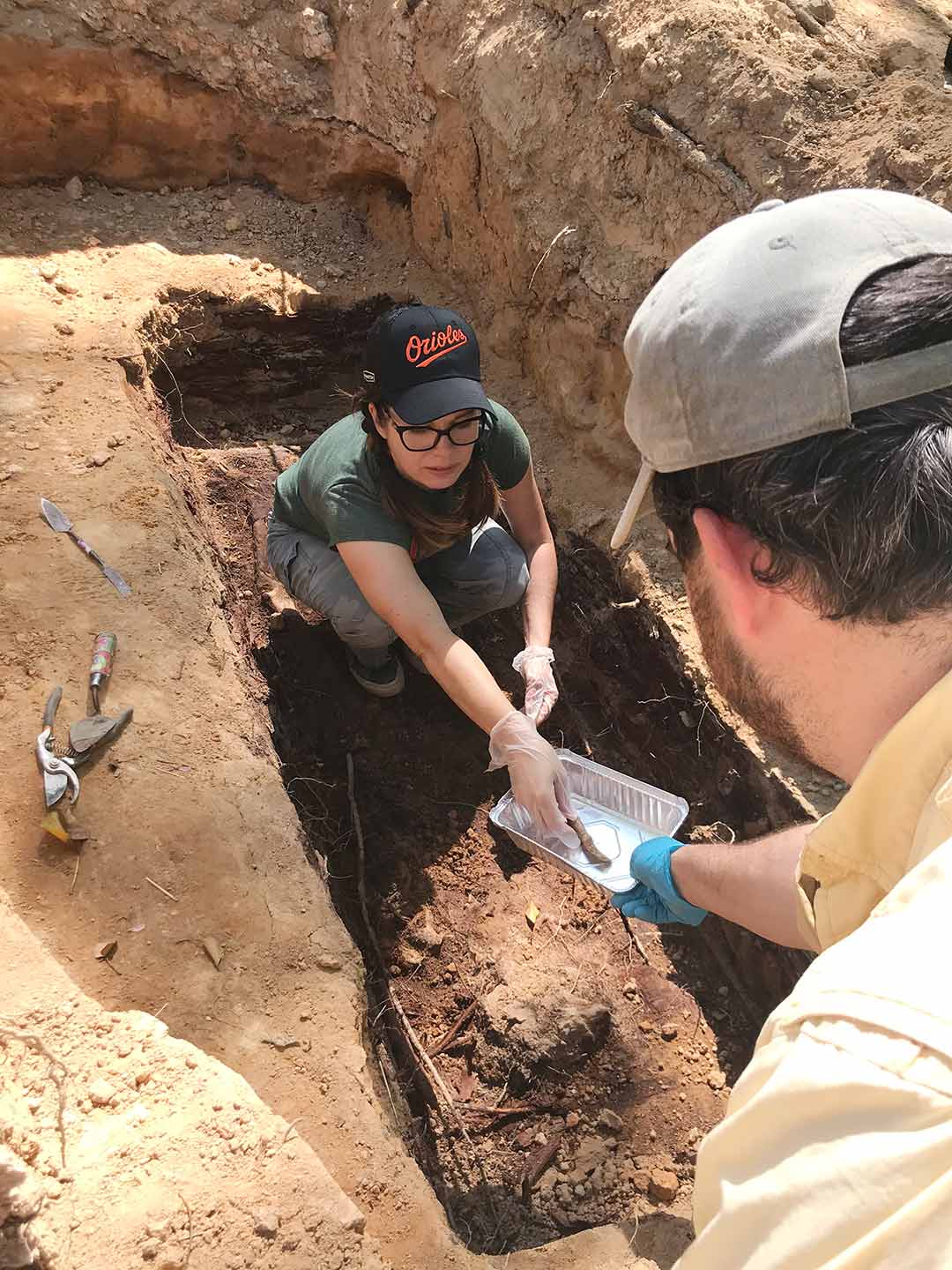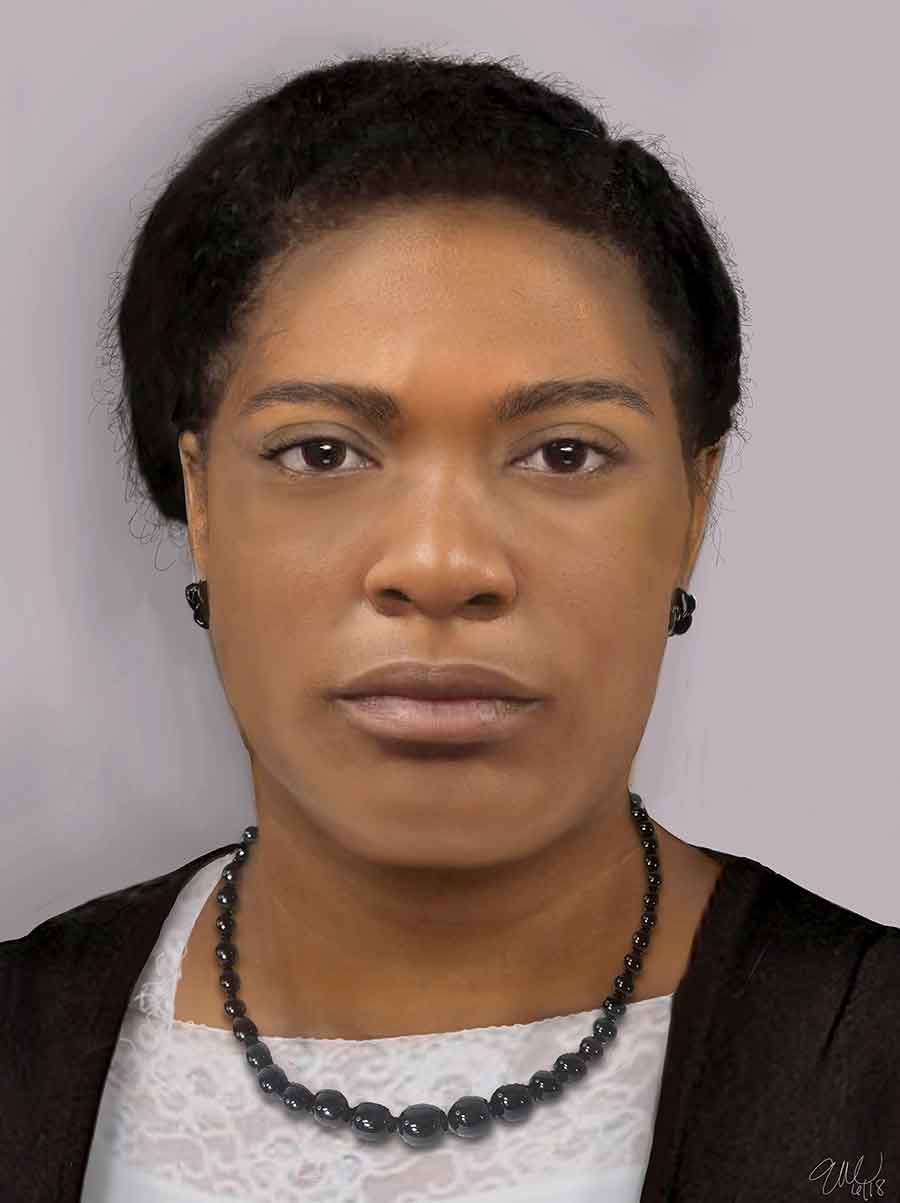- March 06, 2020
- By Maya Pottiger ’17, M.Jour. ’20
On the count of three, archaeologist Julie Schablitsky and her team heaved the lid off a metal burial vault. She teared up and turned away from what lay inside: flowers and ferns, long dead, heaped lovingly over the casket of a Maryland woman buried some 80 years before.
The gravesite was in Hyatsville’s abandoned Simon Hill cemetery, relocated about 50 years ago when the land that had belonged to a Baptist church founded by enslaved Marylanders was bought by the Maryland State Highway Administration—but this grave and dozens of others had been left behind.
 The surprise over the foliage, however, was nothing compared to the shock when the team opened the casket and found inside an almost perfectly preserved body. “We were awestruck,” said Schablitsky, chief archaeologist for the State Highway Administration and adjunct assistant anthropology professor at the University of Maryland. “It looked as if she had just died yesterday.”
The surprise over the foliage, however, was nothing compared to the shock when the team opened the casket and found inside an almost perfectly preserved body. “We were awestruck,” said Schablitsky, chief archaeologist for the State Highway Administration and adjunct assistant anthropology professor at the University of Maryland. “It looked as if she had just died yesterday.”
The exhumation, which began in 2017, was the subject of a Maryland Public Television documentary, “The Dig: A Maryland Mystery Lady,” that aired Feb. 20 and is available for viewing at the MPT website.
As recounted in the show, after the excitement and emotion of the discovery, the team’s next step was to try to identify the unknown woman to track down relatives or descendants to participate in a respectful reburial elsewhere.
“There's the excitement of being able to find these people who are lost and reintroduce them to their descendants,” she said in an interview. “There’s a reason we do what we do.”
Despite the amazing condition of that body, it wasn’t as easy as running its genetic material through a system; researchers needed an idea of whose DNA to compare hers to.
A glaring clue was resting by the woman’s legs: a newspaper dated Sept. 11, 1938, spread open to keep her dress lying flat. Using that date, genealogy hobbyist Violetta Sharps Jones, who was helping Schablitsky, combed through newspaper obituaries and the church’s burial records, which suggested a possible identity. The next step was tracking down potential descendants—found in New Jersey and California—and collecting their DNA samples to compare.
It took a year to get the results, but it was a perfect match. The Mystery Lady was revealed to be Elizabeth James Williams, who died in 1938 at age 51.
 This project was personal for Sharps Jones, who had spent years searching for Simon Hill cemetery, where she believed six of her own family members were buried. An official at the church connected Schablitsky with Sharps Jones, who discovered she had an additional 14 family members buried in the cemetery.
This project was personal for Sharps Jones, who had spent years searching for Simon Hill cemetery, where she believed six of her own family members were buried. An official at the church connected Schablitsky with Sharps Jones, who discovered she had an additional 14 family members buried in the cemetery.
Having the opportunity to connect many people with past family members was overwhelming, especially when it came to Williams, Sharps Jones said.
“They didn’t know her name, they didn’t know she existed, but they immediately connected as though they had lost a close relative,” Sharps Jones said. “They were so moved that we reached out to them. It really does make a difference.”
For Schablitsky, when it comes to sensitive projects like this, she chooses to connect with her subjects rather than emotionally detach. Her work focuses on the African American community, and Schablitsky said she values being able to help awaken families to their history, after seeing so much of it torn away previously.
However, not every burial can be connected to descendants. After the excavation, many sets of remains from the cemetery were sent to the Towson University Archaeology and Forensic Science Lab for DNA testing. Unlike the body of Elizabeth Williams, most were too decomposed to yield results.
“When archeologists are dealing with cemeteries, they must be done with the descendent communities alongside you,” Schablitsky said. “You should never be entering into any of these stories, especially with how difficult and sensitive they are.”
While working with burial sites isn’t new for Schablitsky, an emotional toll remains. She said it was hard to sleep after discovering Williams’ body.
After 74 human remains were uncovered, the project culminated in October 2019 with a recommittal service at the Maryland National Memorial Park. Two caskets went back into the ground: one for Elizabeth James Williams, and the other commemorating the other 73 remains.
Like the families, Schablitsky and her team also found some peace in the reburial ceremony.
“Being able to do what we could and then being able to bury everybody, there's some closure, so we can move on from there,” Schablitsky said.
Topics
Research